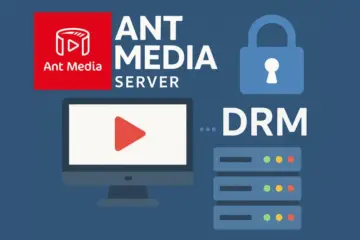Mobile operators can leverage WebRTC in 4G and 5G Networks as a complementary to IMS and this blog post is a summary of a whitepaper called “WebRTC to complement IP Communication Services Version 1.0” by GSMA which considers the different options available for WebRTC from both a commercial and strategic perspective.
Mobile operators could use WebRTC to extend the capabilities of their IMS (IP Multimedia Subsystem)-based infrastructures and expose their services to a larger number of customers and customer devices. Implemented through an internet browser, WebRTC has the advantage of not requiring dedicated client software or a plug-in: all browsers now have built-in support for peer-to-peer real-time communication.
The biggest difference between WebRTC and older web technologies is the user experience: WebRTC is able to access device hardware, such as microphones or cameras, without the need to install a plugin or preload a dedicated communication application.
Benefits of using WebRTC in 4G and 5G Networks

In this section, you will learn the benefits of using WebRTC in 4G and 5G networks. The benefits for mobile operators to consider when implementing WebRTC-based services can be grouped into five main categories:
Cost Reduction
Licensing and integration costs for WebRTC-based solutions are much cheaper than is typically the case for license-based vendor solutions.
For example, equipping call centers with WebRTC technology and using WebRTC in 4G and 5G networks, rather than maintaining high-cost toll-free numbers, with guaranteed quality of service (operator values), can significantly reduce implementation, operation, and maintenance costs for enterprises.
Ease of Use
WebRTC can be used to deliver video and audio calls to a range of web browsers on any device without the need to download and install any clients. Moreover, WebRTC supports contextual communications that allow the end users to stay on the website, navigating and making calls or sending messages, without the need to use a separate device or to leave the page they are looking at.
Security
All communications using WebRTC are fully encrypted between peers. Unlike legacy PSTN systems, with WebRTC technology, encryption is still a major contributor to end-to-end security for consumers and enterprises. Using WebRTC in 4G and 5G networks will provide you a secure system.
Fast Time to Market
Communication services can be developed quickly using WebRTC technology. Web developers can easily integrate communication features into their applications and deliver enterprise business flows immediately on the web. Furthermore, worldwide, there are more web developers than any other set of developers, with a large supportive community and online documentation. Therefore, developing for the web is easier and faster than in other environments.
Simplified Device integration
WebRTC could simplify the integration of voice and video services for device manufacturers, as WebRTC services rely mainly on browsers and programs, which permit swift and frequent upgrades. Thus, mobile operators do not need to wait for or stay synchronized with, the development cycle of devices.
WebRTC – IMS Integration
For IMS-based deployments, WebRTC enables the expansion of communication services to any endpoint with a WebRTC-compliant browser (or native client). The strengths of WebRTC and IMS-based services complement each other
WebRTC
- Clientless environment
- No plug-ins required
- Secure peer-to-peer audio / video communications
- Secure data transfer between peers
- Codec support
IMS Based Services
- Provides end-to-end capability detection
- No need for browser resources
- Supports quality of service
- Allow address book integration
- Supports presence
- Transcoding is done in IMS
WebRTC can support any audio or video codec that has the session description defined by the IETF. The codecs that should be implemented include the pervasive H.264, VP8 for video and G.711 for audio (AMR-WB is optional). A common set of codes will ensure a call can always be completed.
Alignment with 5G Networks
5G mobile network technologies are in the early phases of deployment and becoming part of lives. However, it is likely that WebRTC services delivered over 5G will benefit from improvements such as:
- Much lower latency
- Much greater bandwidth
- Ultra-high reliability
- Guaranteed security, trust, identity, and privacy
For example, 5G could enable person-to-person or person-to-group UHD (Ultra High Definition) mobile video communication via WebRTC. Today, this use case would put a very high load on the network or probably would not work at all, but, with 5G, pervasive video, such as collaboration in 3D cyber-office, may well be a feasible use case.
Employing WebRTC-based applications for demanding use cases, such as gaming, remote control, tactile internet, or e-health, will be highly feasible in the 5G environment.
Sample Use Cases
Mobile operators can support WebRTC with a range of value-added services. These include:
- Centralized Server for Multipart Conferencing:
- Enable third-party developers to create multi-party messaging, voice or video conversations, or broadcasts
- Media Transcoding such as VP8 vs H.264:
- Convert media between WebRTC standards and common Telco standards to enable interoperability
- Interworking with IMS:
- Connect to operator-hosted IMS functions, such as voice/messaging services
- Centralized Server for Media Recording:
- Enable recording of conversations and conferences set up through a server
- Human to Machine / Machine to Human (IoT)
- Click to Call:
- Simple mechanism to connect customers by proving a button in the web domain for the customer to connect directly to sales or care organizations
- Voting:
- Simple mechanisms for users to express preferences within the web environment. For example, an audience voting for favorite characters in TV shows may use the web channel in addition to SMS
- File Exchange and Transfer:
- File transfer within the context of a conversation between two parties. For example, multimedia messaging in which the sender uses WebRTC and the receiver has an IP-connected device.
- Video conferencing:
- Video conversation or broadcast between single or multiple parties
- Developer (network and device) API driven by carrier:
- Exposure of operator core network functionality through APIs.
- Enterprise services:
- End-to-end B2B services, such as click-to-call-for-call centers, video customer care support, internal audio-video conference, etc.
- Interworking with IMS:
- Enabling extension of IMS functionality into the web domain for services such as voice/messaging services
- Carrier as WebRTC Identity Provider:
- Telco IDs such as MSISDN may be used for WebRTC-based authentications.
- Video Call Centre:
- Video calling proposition with booking and service management wrap around on top of basic video functionality.
Summary
It is clear that there are many benefits of using WebRTC in 4G and 5G networks. An important technology and standard in the communications industry, WebRTC can offer contextual communication. It is a baseline for platform and API providers, and enables opportunities for mobile operators to extend their IMS-based solutions, such as RCS and VoLTE. It also creates a new ecosystem for communication service providers, web developers, and cloud vendors. It presents several business opportunities and multiple different business models for mobile operators, as described in this document.


